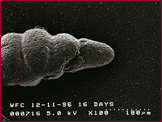



Objectives
Plants can be grown in microgravity and utilized effectively in life support systems. The goal of the Greenhouse 2 investigation was to investigate the effects of microgravity on the productivity of a crop plant, specifically dwarf wheat; to identify the chemical, biochemical, and structural changes in plant tissues induced by microgravity; to determine microgravity's effect on plant processes, such as photosynthesis and water use; and to evaluate current facilities for plant growth aboard the Mir Space Station.
Shuttle-Mir Missions Approach Results
The plant growth exhibited during Mir 19 was inconsistent with previous plant growth experiments in microgravity. The plants remained completely vegetative throughout the entire experiment. No wheat heads were detected on any of the samples, and no videos or photos showed any sign of heads on the plants. Some mature plants had as many as 18 leaves compared with a normal 8 leaves. Apparently, the growing meristems never became reproductive and produced only leaves. Difficulties with hardware resulted in low light, high temperatures and water-logging and were suspected as contributing factors to the inconsistent plant growth. The observation that the plants remained vegetative could lead to important insights about plant growth in general and in microgravity as more ground studies are carried out.
Publications
Salisbury, F. B., G. E. Bingham, W. F. Campbell, J. G. Carman, D. L. Bubenheim, B. Yendler and G. Jahns. 1995. Growing super-dwarf wheat in Svet on Mir. Life Support and Biosphere Science 2:31-39.
Bingham, G. E., S. B. Brown, F. B. Salisbury, W. F. Campbell, J. G. Carman, G. Jahns, D. Pletcher, D. B. Bubenheim, B. Yendler, V. Sytchev, M. A. Levinskikh, I. Podolsky, I. Ivanova, P. Kosgtov and S. Sapunovca. 1996. Environmental measurements observed during the greenhouse-2 experiment on the Mir orbital station. COSPAR 31:364.
Bingham, G., F. Salisbury, W. Campbell, J. Carman, B. Y. Yendler, V. S. Sytchev, Y. B. Berkovich, M. A. Levinskikh and I. Podolsky. 1996. The spacelab-Mir-1 "Greenhouse-2" experiment. Adv. Space Res. 18:225-232.
Salisbury, F. B., W. F. Campbell, J. Carman, G. Bingham, D. L. Bubenheim, B. Yendler, V. Sytchev, M. A. Levinskikh, I. Ivanova, L. Chernova and I. Podolsky. 1996. Plant growth during the greenhouse II experiment on the Mir orbital station. COSPAR 31:364.
Yendler, B., G. Bingham, S. Jones, and I. Podolsky. 1995. Moisture sensor for use in microgravity. SAE Paper No 951471. 25th International Conference on Environmental Systems, San Diego, CA.
Yendler, B., and R. Bula. 1995. Capillary testbed: Design modifications and preliminary study. SAE Paper No 951472. 25th International Conference on Environmental Systems, San Diego, CA.
� Principal Investigators
Margarita Levinskikh, Ph.D.![]()
Mir 19
Wheat was planted once during this mission. The plants were grown in the "Svet" (a Russian/Slovokian developed plant growth facility), where photosynthesis, transpiration and the physiological state of the plants was monitored. The plants were observed daily, and photographs and video images were taken. Samples were collected at certain developmental stages and were either fixed or dried for return to Earth.
Because of the limited amounts of tissue obtained from Mir-grown wheat, histochemical staining was used to determine the structural, cellular, physiological and biochemical differences of the microgravity grown plants. In Earth-grown wheat plants, lignin was heavily concentrated in the bundle sheath, xylem and sclerenchyma cells. In the Mir-grown wheat, lignin was present only in the xylem region of the mid-rib but less concentrated than in Earth-grown wheat. Starch deposition in crop and other plants depends greatly on the history of exposure to light and time of harvest. Since the Mir plants were grown under such limited lighting conditions up until the time of harvest, it was unlikely that these plants would have matched the starch production of of Earth-grown plants exposed to much higher light levels (sunlight, high-pressure sodium lamps). In addition, Mir-grown wheat exhibited cellulose-stained cells in the epidermal cells of the leaf, whereas the cellulose-stained cells of Earth-grown wheat were in the mesophyll.
Bingham, G. E., F. B. Salisbury, W. F. Campbell and J. G. Carman. 1994. The Spacelab-Mir-1 "Greenhouse-2" experiment. Microgravity Science and Technology 18(3):58-65.
Frank B. Salisbury, Ph.D.
Utah State University
Institute of Biomedical Problems
![]()
|
|
Curator:
Julie Oliveaux
Responsible NASA Official: John Uri |
Page last updated: 07/16/1999
.gif)